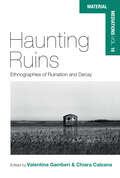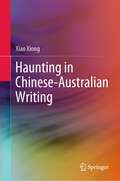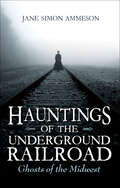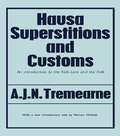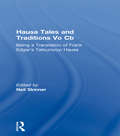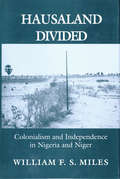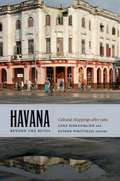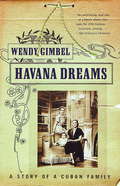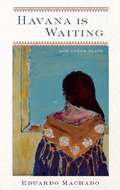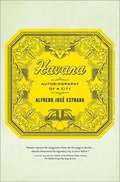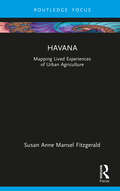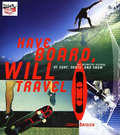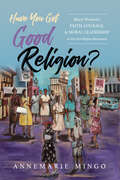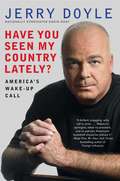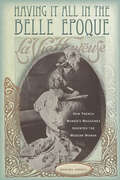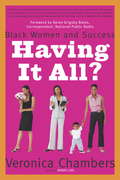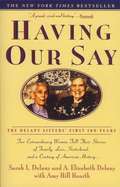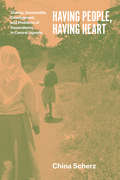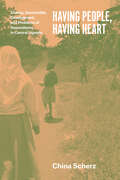- Table View
- List View
Haunting Ruins: Ethnographies of Ruination and Decay (Material Mediations: People and Things in a World of Movement)
by Valentina Gamberi Chiara CalzanaRuins, rubble and decaying material can foster a more layered theory of time, change and memory. The seven ethnographic case studies in Haunting Ruins trace human engagements with the temporal forces of ruins, which can trace the past and transform the present. Conjuring environmental humanities, the anthropology of history, memory and archaeology, this book delves into the complex influence of the past on the present and the future and urges scholars to consider ruins as things to think with.
Haunting in Chinese-Australian Writing
by Xiao XiongThis book examines haunting in terms of trauma, languaging, and the supernatural in works by Chinese Australian writers born in Australia, Mainland China, Hong Kong, Malaysia, and Singapore. It goes beyond the conventional focus on identity issues in the analysis of diasporic writing, considering how the memory of past trauma is triggered by abusive systems of power in the present. The author unpacks how trauma also brings past violence to haunt the present. This book considers how different Chinese diasporic communities present a dynamic and multiple state through partial erasure between different Chinese subcultures and other cultures.Showing the supernatural as a social and cultural product, this book elucidates how haunting as the supernatural refers to the coexistence of, and the competition between, different cultures and powers. It takes a wide-ranging view of different diasporic communities under the banner ‘Chinese’, a term that refers not only to Chinese nationals in terms of citizenship, but also to the Chinese diaspora in terms of ancestry, and Chinese culture more generally. In analysing haunting in texts, the author positions Chinese culture as in a constant state of flux. It is relevant to literary scholars and students with interests in Australian literature, Chinese and Southeast Asian migration writing, and those with an interest in the Gothic and postcolonial traditions.
Haunting the Korean Diaspora: Shame, Secrecy, and the Forgotten War
by Grace M. ChoSince the Korean War—the forgotten war—more than a million Korean women have acted as sex workers for U.S. servicemen. More than 100,000 women married GIs and moved to the United States. Through intellectual vigor and personal recollection, Haunting the Korean Diaspora explores the repressed history of emotional and physical violence between the United States and Korea and the unexamined reverberations of sexual relationships between Korean women and American soldiers. Grace M. Cho exposes how Koreans in the United States have been profoundly affected by the forgotten war and uncovers the silences and secrets that still surround it, arguing that trauma memories have been passed unconsciously through a process psychoanalysts call &“transgenerational haunting.&” Tracing how such secrets have turned into &“ghosts,&” Cho investigates the mythic figure of the yanggongju, literally the &“Western princess,&” who provides sexual favors to American military personnel. She reveals how this figure haunts both the intimate realm of memory and public discourse, in which narratives of U.S. benevolence abroad and assimilation of immigrants at home go unchallenged. Memories of U.S. violence, Cho writes, threaten to undo these narratives—and so they have been rendered unspeakable.At once political and deeply personal, Cho&’s wide-ranging and innovative analysis of U.S. neocolonialism and militarism under contemporary globalization brings forth a new way of understanding—and remembering—the impact of the Korean War.
Hauntings of the Underground Railroad: Ghosts of the Midwest
by Jane Simon AmmesonStories of the runaway slaves who left their spirits behind. “An easy read and an odd collection of tales of murders, mayhem, madness, and sadness.” —FolkloreBefore the Civil War, a network of secret routes and safe houses crisscrossed the Midwest to help African Americans travel north to escape slavery. Although many slaves were able to escape to the safety of Canada, others met untimely deaths on the treacherous journey—and some of these unfortunates still linger, unable to rest in peace. In Hauntings of the Underground Railroad: Ghosts of the Midwest, Jane Simon Ammeson investigates unforgettable and chilling tales of these restless ghosts that still walk the night. This unique collection includes true and gruesome stories, like the story of a lost toddler who wanders the woods near the Story Inn, eternally searching for the mother torn from him by slave hunters, or the tale of the Hannah House, where an overturned oil lamp sparked a fire that trapped slaves hiding in the basement and burned them alive. Brave visitors who visit the house, which is now a bed and breakfast, claim they can still hear voices moaning and crying from the basement. Ammeson also includes incredible true stories of daring escapes and close calls on the Underground Railroad. A fascinating and spine-tingling glimpse into our past, Hauntings of the Underground Railroad will keep you up all night.
Haunts of Virginia's Blue Ridge Highlands (Haunted America)
by Joe TennisThis &“interesting collection of Southwest Virginia ghost stories&” is packed with pictures and Appalachian lore (Roanoke Star-Sentinel). A Confederate soldier forever lost at Cumberland Gap. The wispy woman of Roanoke College. The spectral horse that runs the streets of Abingdon. These are just a few of the restless spirits of southwestern Virginia. Join local author Joe Tennis as he takes readers on both sides of the Blue Ridge to explore the ghostly tales of Appalachia and the Crooked Road. Peer over the rim of the New Castle Murder Hole, dive into the mysteries of Mountain Lake, and wander among the lost graves of Wise County to discover the haunted lore of Virginia&’s Blue Ridge Highlands. This book bridges the Blue Ridge Parkway and follows the entire length of the Crooked Road: Virginia&’s Heritage Music Trail. It explores a couple dozen counties, with tales of towns called Fincastle and Saltville tucked away in Virginia&’s scenic southwestern corner. Each chapter is based on a blend of folk legends, longtime traditions, historical research, and firsthand accounts—and the book also includes a bibliography, a map, and forty-five photographs.
Hausa Superstitions and Customs: An Introduction to the Folk-Lore and the Folk
by Major A.J.N. TremearneFirst Published in 1970. Routledge is an imprint of Taylor & Francis, an informa company.
Hausa Tales and Traditions: Being a translation of Frank Edgar's Tatsuniyoyi Na Hausa (Routledge Revivals Ser.)
by Frank EdgarFirst Published in 1969. This is a translation from Hausa of Frank Edgar’s three volumes of his African folktale, Tatsunijoyi Na Hausa, his major work. The Hausa whose folklore Edgar recorded so industriously are the largest ethnic group in Northern Nigeria and number many millions.
Hausaland Divided: Colonialism and Independence in Nigeria and Niger
by William F. MilesHow have different forms of colonialism shaped societies and their politics? William F. S. Miles focuses on the Hausa-speaking people of West Africa whose land is still split by an arbitrary boundary established by Great Britain and France at the turn of the century.
Havana Beyond the Ruins: Cultural Mappings after 1989
by Anke Birkenmaier Esther WhitfieldIn Havana beyond the Ruins, prominent architects, scholars, and writers based in and outside of Cuba analyze how Havana has been portrayed in literature, music, and the visual arts since Soviet subsidies of Cuba ceased, and the Cuban state has re-imagined Havana as a destination for international tourists and business ventures. Cuba's capital has experienced little construction since the revolution of 1959; many of its citizens live in poorly maintained colonial and modernist dwellings. It is this Havana--of crumbling houses, old cars, and a romantic aura of ruined hopes--that is marketed in picture books, memorabilia, and films. Meanwhile, Cuba remains a socialist economy, and government agencies maintain significant control of urban development, housing, and employment. Home to more than two million people and a locus of Cuban national identity, Havana today struggles with the some of the same problems as other growing world cities, including slums and escalating social and racial inequalities. Bringing together assessments of the city's dwellings and urban development projects, Havana beyond the Ruins provides unique insights into issues of memory, citizenship, urban life, and the future of the revolution in Cuba. Contributors Emma lvarez-Tabo Albo Eric Felipe-Barkin Anke Birkenmaier Velia Cecilia Bobes Mario Coyula-Cowley Elisabeth Enenbach Sujatha Fernandes Jill Hamberg Patricio del Real Cecelia Lawless Jacqueline Loss Orlando Luis Pardo Lazo Antonio Jos Ponte Nicols Quintana Jose Quiroga Laura Redruello Rafael Rojas Joseph L. Scarpaci Esther Whitfield
Havana Dreams
by Wendy GimbelA fascinating, powerfully evocative story of four generations of Cuban women, through whose lives the author illuminates a vivid picture--both personal and historical--of Cuba in our century."When I want to read a culture," writes Wendy Gimbel in her prologue, "I listen to stories about families, sensing in their contours the substance of larger mysteries." And certainly in the Revuelta family she has found a source of both mystery and revelation. At its center is Naty: born in 1925, educated in the United States, a socialite during the Batista era, who after marriage to a prominent doctor and the birth of a daughter became intoxicated with Castro and his revolution (here, published for the first time, are the letters they exchanged while he was in jail). Though her husband and daughter immigrated to the United States after Castro's victory, Naty remained in Cuba to raise her second child, Castro's unacknowledged daughter, only to be ultimately confronted by his dismissive, withering judgment: "Naty missed the train." Her two daughters, one of whom settles well into life in America, while the other never recovers from her father's intransigent repudiation of her; her granddaughter, who Naty desperately believes will return to Cuba when--not if--Castro is removed from the island; and her mother, an unregenerate reactionary: these are the lives that complete this extraordinary story.Each of the women is irrevocably marked with a part of the island's terrible and poignant tale, and Wendy Gimbel has created a rich and intense narrative of their lives and times. Havana Dreams leaves us with an indelible impression of familial obligation and illicit love; of the heady but doomed romanticism of revolution; and of the profound consequences of Cuba's contemporary history for the ordinary and most intimate lives of its people.From the Hardcover edition.
Havana is Waiting and Other Plays
by Eduardo Machado"The existential pain of exile, the confusions of sexual identity and the complex legacies of the Cuban revolution are predominant [in] Mr. Machado's writing," -The New York TimesEduardo Machado explores his lifelong themes with humor and passion in Havana Is Waiting (a writer returns to Cuba after thirty years), Kissing Fidel (a comedy set in Miami funeral parlor), The Cook (chronicling Cuban history), and Crocodile Eyes (inspired by Federico García Lorca).Eduardo Machado is the author of more than forty plays. Born in Cuba, his plays have been widely performed. He is artistic director of INTAR Theatre and head of playwriting at New York University.
Havana: Autobiography of a City
by Alfredo José EstradaAlfredo José Estrada's intimate ties to Havana form the basis for this "autobiography," written as though from the city's own heart. Covering the island's five hundred year history, Estrada portrays the adventurers and dreamers who left their mark on Havana, including José Martí, martyr for Cuban independence; and Ernest Hemingway, the most American of writers who became an unabashed Habanero. Deeply personal and affecting, Havana is the accessible and complete story of the city for the history buff and armchair traveler alike.
Havana: Mapping Lived Experiences of Urban Agriculture (Built Environment City Studies)
by Susan Anne FitzgeraldFollowing the crisis of the Special Period, Cuba promoted urban agriculture throughout its towns and cities to address food sovereignty and security. Through the adoption of state recommended design strategies, these gardens have become places of social and economic exchange throughout Cuba. This book maps the lived experiences surrounding three urban farms in Havana to construct a deeper understanding about the everyday life of this city. Using narratives and drawings, this research uncovers these sites as places where education, intimacy, entrepreneurism, wellbeing, and culture are interwoven alongside food production. Henri Lefebvre’s latent work on rhythmanalysis is used as a research method to capture the everyday beats particular to Havana surrounding these sites. This book maps the many ways in which these spaces shift power away from the state to become places that are co-created by the community to serve as a crucial hinge point between the ongoing collapse of the city and its future wellbeing.
Have Board, Will Travel: The Definitive History of Surf, Skate, and Snow
by Jamie BrisickWhether on water, pavement, or fluffy white powder, the history of surfing,skateboarding, and snowboarding is a landscape filled with rugged personalities, exotic locales, wild innovation, and most of all the united dream of becoming one with the oceans, streets, and mountains. Have Board, Will Travel shows the intricate connection between all three sports. Their histories act as the grand foundation, the images serve as divine inspiration, and each page is filled with enough side-stanced glory to summon even the laziest couch potato to pick up a board and ride.
Have I Got a Guy for You
by Alix StraussDaughters everywhere will appreciate the dating Catch-22 in this take-no-prisoners collection of true stories in which readers meet 26 victims of Mom's well-meaning meddling.
Have I Got a Guy for You
by Alix StraussThe good news is: You've got a date. The bad news is: Your mother sent him. Picture this: Mom swears she's found "the one" for you, her baby girl, and you end up on the date from hell. If you've been there, done that, you'll appreciate the dating catch-22 that is Have I Got a Guy for You. In this take-no-prisoners collection of hilarious, wince-inducing true stories, you'll meet two dozen victims of Mom's well-meaning meddling and hear the unvarnished details of what they suffered through: 1. The schoolteacher who never wants to leave his house-or the couch 2. The mother who writes letter after letter to Michael Gelman, then-producer of LIVE with Regis & Kathie Lee, hoping to persuade him to ask her daughter out 3. The woman who's set up with her cousin-by-marriage 4. The writer who endures eights hours of a Dungeons & Dragons convention 5. The over-zealous actor who performs a monologue at Starbucks 6. And the lawyer who sadly can't perform . . . at all
Have I Got a Guy for You: What Really Happens When Mom Fixes You Up
by Alix StraussA Simon & Schuster eBook. Simon & Schuster has a great book for every reader.
Have You Got Good Religion?: Black Women's Faith, Courage, and Moral Leadership in the Civil Rights Movement
by AnneMarie MingoWhat compels a person to risk her life to change deeply rooted systems of injustice in ways that may not benefit her? The thousands of Black Churchwomen who took part in civil rights protests drew on faith, courage, and moral imagination to acquire the lived experiences at the heart of the answers to that question. AnneMarie Mingo brings these forgotten witnesses into the historical narrative to explore the moral and ethical world of a generation of Black Churchwomen and the extraordinary liberation theology they created. These women acted out of belief that what they did was bigger than themselves. Taking as their goal nothing less than the moral transformation of American society, they joined the movement because it was something they had to do. Their personal accounts of a lived religion enacted in the world provide powerful insights into how faith steels human beings to face threats, jail, violence, and seemingly implacable hatred. Throughout, Mingo draws on their experiences to construct an ethical model meant to guide contemporary activists in the ongoing pursuit of justice. A depiction of moral imagination that resonates today, Have You Got Good Religion? reveals how Black Churchwomen’s understanding of God became action and transformed a nation.
Have You Seen My Country Lately?
by Jerry Doyle"I've seen my country lately. Frankly, I don't like what I see. Nevertheless, it's not too late to restore the great and unique wonder that is the United States. We are the beacon of hope for the world, and we will remain so as long as we stand up for our principles." In keeping with his no-holds-barred on-air style, conservative radio talk show host Jerry Doyle has the guts to ask the tough questions about the state of our nation today. In this informative, entertaining, and challenging narrative, he urges Americans to take back the things that make our country great, and delivers his hard-hitting and oftentimes humorous spin on: * ECONOMIC FASCISM--the rapid government domination that began with the egregious takedown of GM * BAILOUTS--the missteps, wrong moves, and rules of salary caps, bank buy-ins, and bonuses that changed from day to day * EDUCATION--how our "everybody wins" obsession is destroying teaching and fostering an obnoxious self-entitlement trend * THE OBAMA PRESIDENCY--will American capitalism survive this administration? . . . and much more. If you like your politics straight up, with a commonsense chaser and a shot of dry wit, you'll be galvanized and enlightened by Jerry Doyle--the man, his story, and his insights into America today.
Having It All in the Belle Epoque: How French Women's Magazines Invented the Modern Woman
by Rachel MeschAt once deeply historical and surprisingly timely, "Having it All in the Belle Epoque" shows how the debates that continue to captivate high-achieving women in America and Europe can be traced back to the early 1900s in France. The first two photographic magazines aimed at women, "Femina" and "La Vie Heureuse" created a female role model who could balance age-old convention with new equalities. Often referred to simply as the "modern woman," this captivating figure embodied the hopes and dreams as well as the most pressing internal conflicts of large numbers of French women during what was a period of profound change. Full of never-before-studied images of the modern French woman in action, "Having it All" shows how these early magazines exploited new photographic technologies, artistic currents, and literary trends to create a powerful model of French femininity, one that has exerted a lasting influence on French expression. This book introduces and explores the concept of Belle Epoque literary feminism, a product of the elite milieu from which the magazines emerged. Defined by its refusal of political engagement, this feminism was nevertheless preoccupied with expanding womens roles, as it worked to construct a collective fantasy of female achievement. Through an astute blend of historical research, literary criticism, and visual analysis, Meschs study of womens magazines and the popular writers associated with them offers an original window onto a bygone era that can serve as a framework for ongoing debates about feminism, femininity, and work-life tensions.
Having It All? Black Women and Success
by Veronica ChambersA behind-the-scenes look into the lives of successful middle- and upper-middle class African American women, the groundbreaking HAVING IT ALL? is sure to spark discussions from cocktail parties to boardrooms. In a single generation, black women have made extraordinary strides academically, professionally, and financially. They've entered the workplace at a far greater rate than white women; increased their enrollment in law schools and graduate programs by 120 percent; and many are now running top companies, or in some cases, the country. Isn't that enough? Not necessarily. With sharp insight, award-winning journalist Veronica Chambers explores the challenges and stereotypes she and other African American women continue to endure, and answers the question most often posed to her: What does success mean for black women? Twenty-first century black women draw their inspiration from a wide range of sources: Claire Huxtable to Audrey Hepburn, snowboarding to basketball, Gloria Steinem to bell hooks. They choose what they like. Yet they are misunderstood by mainstream America and lack an accurate portrayal in the media of their lives. HAVING IT ALL? interweaves the thoughts and reflections of more than fifty women who occupy this territory. The voices range from Thelma Golden, chief curator of The Studio Museum in Harlem, to a Silicon Valley executive, to medical and legal professionals, and stay-at-home "mocha moms." Successful black women today want it all: marriage, motherhood, engaging work, and prosperity. The difference is that they come to the table with the strength, courage and wisdom of black women ancestors who-did-it-all, even when they didn't-have-it-all. What has gone so undocumented by the media is that modern black women are coming up with creative, satisfying answers to the juggling act that all women face. Veronica Chambers chronicles this topic for the first time in her absorbing, riveting and groundbreaking book HAVING IT ALL?
Having None of It
by Adrienne SuIn this third collection, award-winning poet Adrienne Su reflects deeply about the circumstances in which people are forced to remake themselves: as parents, as immigrants, as people whose marriages have ended, as people who've wound up in a place they never intended to settle.From "Breakup":Another ending finds its placeamong novels, lives, summersthat fled, but this kind has a wayof getting filed under failure:yes, the relationship failed,if to fail is to fail to endure.
Having Our Say: The Delany Sisters' First 100 Years
by Amy Hill Hearth Sarah L. Delany A. Elizabeth DelanyWarm, feisty, and intelligent, the Delany sisters speak their mind in a book that is at once a vital historical record and a moving portrait of two remarkable women who continued to love, laugh, and embrace life after over a hundred years of living side by side. Their sharp memories show us the post-Reconstruction South and Booker T. Washington; Harlem's Golden Age and Langston Hughes, W. E. B. Du Bois, and Paul Robeson. Bessie breaks barriers to become a dentist; Sadie quietly integrates the New York City system as a high school teacher. Their extraordinary story makes an important contribution to our nation's heritage--and an indelible impression on our lives.
Having People, Having Heart: Charity, Sustainable Development, and Problems of Dependence in Central Uganda
by China ScherzBelieving that charity inadvertently legitimates social inequality and fosters dependence, many international development organizations have increasingly sought to replace material aid with efforts to build self-reliance and local institutions. But in some cultures--like those in rural Uganda, where Having People, Having Heart takes place--people see this shift not as an effort toward empowerment but as a suspect refusal to redistribute wealth. Exploring this conflict, China Scherz balances the negative assessments of charity that have led to this shift with the viewpoints of those who actually receive aid. Through detailed studies of two different orphan support organizations in Uganda, Scherz shows how many Ugandans view material forms of Catholic charity as deeply intertwined with their own ethics of care and exchange. With a detailed examination of this overlooked relationship in hand, she reassesses the generally assumed paradox of material aid as both promising independence and preventing it. The result is a sophisticated demonstration of the powerful role that anthropological concepts of exchange, value, personhood, and religion play in the politics of international aid and development.
Having People, Having Heart: Charity, Sustainable Development, and Problems of Dependence in Central Uganda
by China ScherzBelieving that charity inadvertently legitimates social inequality and fosters dependence, many international development organizations have increasingly sought to replace material aid with efforts to build self-reliance and local institutions. But in some cultures—like those in rural Uganda, where Having People, Having Heart takes place—people see this shift not as an effort toward empowerment but as a suspect refusal to redistribute wealth. Exploring this conflict, China Scherz balances the negative assessments of charity that have led to this shift with the viewpoints of those who actually receive aid. Through detailed studies of two different orphan support organizations in Uganda, Scherz shows how many Ugandans view material forms of Catholic charity as deeply intertwined with their own ethics of care and exchange. With a detailed examination of this overlooked relationship in hand, she reassesses the generally assumed paradox of material aid as both promising independence and preventing it. The result is a sophisticated demonstration of the powerful role that anthropological concepts of exchange, value, personhood, and religion play in the politics of international aid and development.
